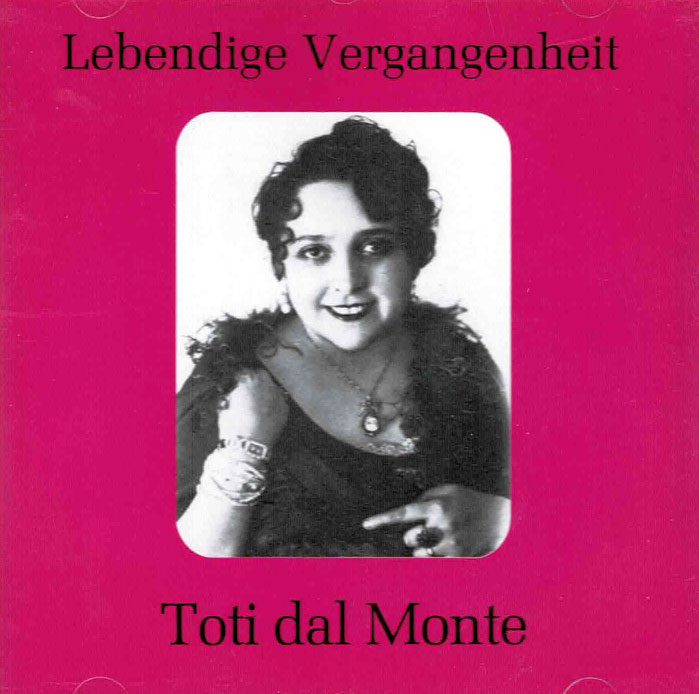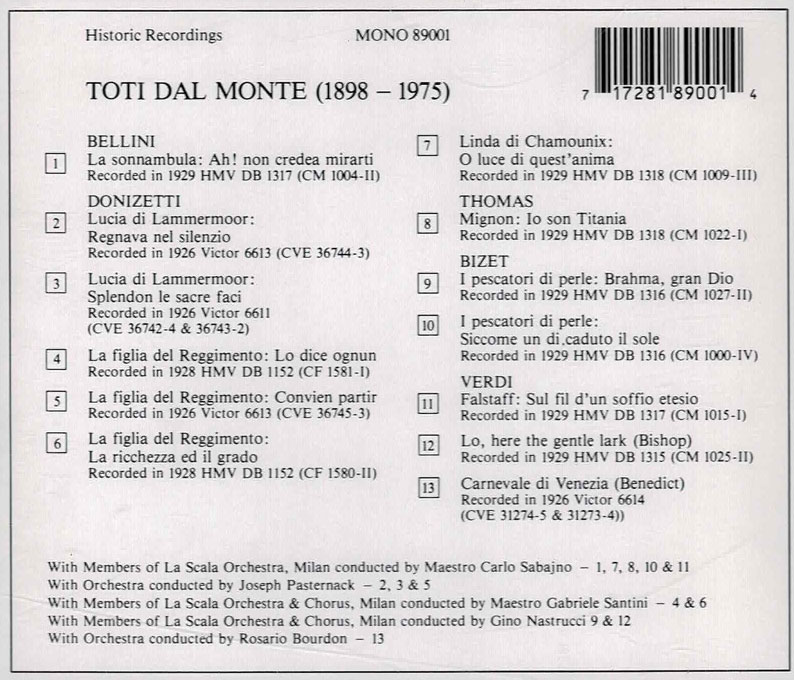Logowanie
Mikołaj - ten to ma gest!
Elton John, The Mamas & The Papas, Cat Stevens, Rod Stewart, Bobbie Gentry, Stevie Wonder, Engelbert Humperdinck
Memory Lane
Edycja Numerowana - 1000 egzemplarzy w skali światowej
RACHMANINOV, Eiji Oue, Minnesota Orchestra
Symphonic Dances / Vocalise
Best Recordings of 2001!!! NAJCZĘŚCIEJ KUPOWANA PŁYTA Z RR!
Karnawał czas zacząć!
Music of Love - Hi-Fi Latin Rhythms
Samba : Music of Celebration
AUDIOPHILE 24BIT RECORDING AND MASTERING
CHOPIN, LISZT, DEBUSSY, DVORAK, Gerhard Oppitz
Dances romantiques - A fantastic Notturno
Wzorcowa jakość audiofilska z Clearaudio
Winylowy niezbędnik
ClearAudio
Double Matrix Professional - Sonic
najbardziej inteligentna i skuteczna pralka do płyt winylowych wszelkiego typu - całkowicie automatyczna
BELLINI, DONIZETTI, THOMAS, VERDI
Toti Dal Monte I

- BELLINI
- DONIZETTI
- THOMAS
- VERDI
Lebendige Vergangenheit
In lists of great exponents of Italian coloratura singing, the two names generally found at the top are those of Amelita Galli-Curci and Toti dal Monte. There have, of course, been many fine coloraturas, notably in Spain and South America, but the two Italians reigned supreme among the virtuosos and set the standard by which whole generations of singers have been measured. The popularity of Galli-Curci and dal Monte is due in no small measure to the records they made. Both of them were darlings of the recording industry. Toti dal Monte gained further public acclaim thartks to her film roles a d her appearances in opera houses all over Europe and America. Apart from their sterling reputation as the leading exponents of one of the most difficult forms of vocal art, the two prima donnas had little in common, including their ages. While Galli-Curci tended to strike the listener as cool and ascetic, Toti dal Monte, the younger of the two, was much more sensuous. Her voice was sweet, mellow and warm; it was one of those infatuating "nightingale voices" which were so highly esteemed in the romantic era. These natural gifts predestined her for Italian romantic opera; she was the ideal interpreter of "visionary" roles in the operas of Bellini ("La Sonnambula") and Donizetti (" Lucia di Lammermoor"). In her singing there was a rare synthesis of technical perfection and expres sive warmth. Toti dal Monte, whose real name was Antonietta Meneghel, began studying music with the intention of becoming a pianist, but on the advice of Ermanno Wolf-Ferrari, who was then the director of the Benedetto Marcello Conservatory in Venice, she switched to singing. For five years, she trained with the renowned vocal pedagogue Barbara Marchisio. So evident was the young singer's talent that she made her debut in Italy's most prestigious opera house: in 1916 she made her first appearance on the stage of La Scala in Milan, in the role of Biancafiore in Zandonai's opera "Francesca da Rimini." After that she sang at several Italian opera houses, and guest performances took her as far as South America. In 1921 she returned to La Scala, singing Gilda in Verdi's "Rigoletto" in a legendary performance under the baton of Arturo Toscanini. The worldwide fame of Toti dal Monte dates from that occasion. In the Milan production of "Rigoletto" she made guest appearances in many European opera houses, some of them in Germany, where she scored triumphant successes. Under Toscanini she sang another of her famous roles, the name part in Donizetti's "Lucia di Lammermoor." Gilda, Lucia, Norina in "Don Pasquale," Rosina in "The Barber of Seville" and Amina in "La Sonnambula" were her greatest successes as a coloratura. Only relatively late did she venture upon Violetta in Verdi's "La Traviata," another of her most impressive achievements. Her most successful lyric-dramatic role was the name part in Puccini's "Madame Butterfly"; in 1939 she sang it in a complete recording of the opera. Toti dal Monte drew enthusiastic audiences not only at La Scala but also at New York's Metropolitan Opera, in Paris,'London, Chicago, Buenos Aires, Berlin, Vienna and many other cities. After the Second World War she retired from the stage and concert hall and became involved with training talented young singers. Toti dal Monte spent the last years of her life at her residence in Barbisano in the Italian province of Treviso. Her name calls to mind a golden age of bel canto art.





























